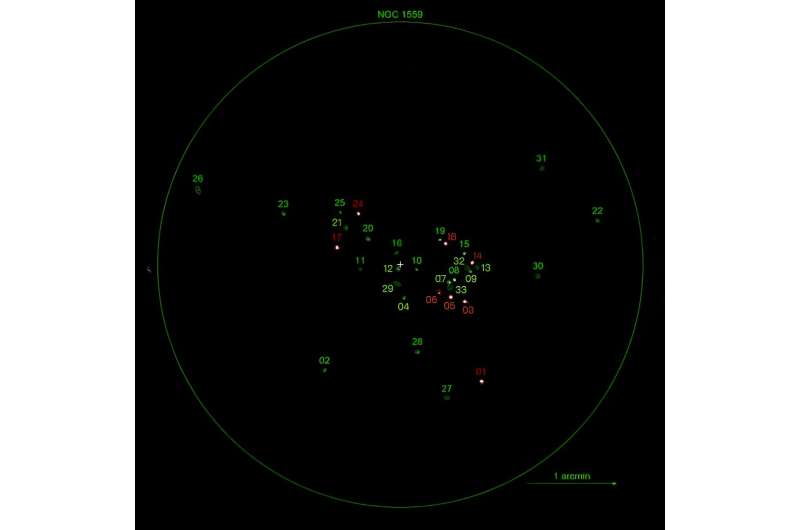August 22, 2023 report
This article has been reviewed according to Science X's editorial process and policies. Editors have highlighted the following attributes while ensuring the content's credibility:
fact-checked
preprint
trusted source
proofread
Astronomers discover eight ultraluminous X-ray sources in NGC 1559

Astronomers from Taiwan have performed X-ray observations of the galaxy NGC 1559 using NASA's Chandra spacecraft. They detected eight new ultraluminous X-ray sources in this galaxy. The finding is reported in a paper published August 10 on the pre-print server arXiv.
Ultraluminous X-ray sources (ULXs) are point sources in the sky that are so bright in X-rays that each emits more radiation than 1 million suns emit at all wavelengths. They are less luminous than active galactic nuclei (AGN), but more consistently luminous than any known stellar process. Although numerous studies of ULXs have been conducted, the basic nature of these sources still remains unsolved.
At a distance of some 41 million light years, NGC 1559 is a barred spiral galaxy in the constellation Reticulum. Despite its fragmented morphology, the spiral arms of NGC 1559 are relatively massive with a high star-formation rate. The galaxy is also known for hosting at least four supernovae in the last 40 years.
A team of astronomers led by Chen-Hsun Ma of the National Cheng Kung University in Taiwan, has investigated NGC 1559 with Chandra's Advanced CCD Imaging Spectrometer (ACIS), focusing on bright X-ray point sources. The observations resulted in the identification of 33 X-ray point sources, out of which eight turned out to be new ULXs.
"We report a study of the X-ray population in NGC 1559 using the Chandra/ACIS observation taken in 2016. 33 X-ray point sources were detected. Among these, there are eight ULXs with X-ray luminosities higher than 1039 erg/s," the researchers wrote in the paper.
The most luminous ULX out of the eight reported in the study is the one designated X-17. It has an X-ray luminosity of about 7.98 duodecillion erg/s in 0.3–7 keV. The astronomers noted that the X-ray luminosity of X-17 even exceeds 10 duodecillion erg/s when considering the upper bound of the error.
Another new ULX worth noticing is the source designated X-6. It is the weakest ULX in NGC 1559, with an X-ray luminosity at a level of 1.06 duodecillion erg/s. Therefore, it could fall into the non-ULX regime. Moreover, X-6 has a photon index larger than 2.5, what indicates a possible thermal origin of the emission—contrary to the other seven ULX that are non-thermal systems.
The authors of the paper underlined that NGC 1559 hosts an unexpectedly large number of ULXs. They offer few hypotheses that could explain this overabundance of these sources in the investigated galaxy.
"We have tried to explain the excess of ULXs using the arguments of low-metallicity or starburst and compared with similar cases of other nearby galaxies. Unfortunately, there is still no satisfactory explanation," the researchers concluded.
More information: Chen-Hsun Ma et al, Chandra Observation of NGC 1559: Eight Ultraluminous X-ray Sources Including a Compact Binary Candidate, arXiv (2023). DOI: 10.48550/arxiv.2308.06287
Journal information: arXiv
© 2023 Science X Network





















